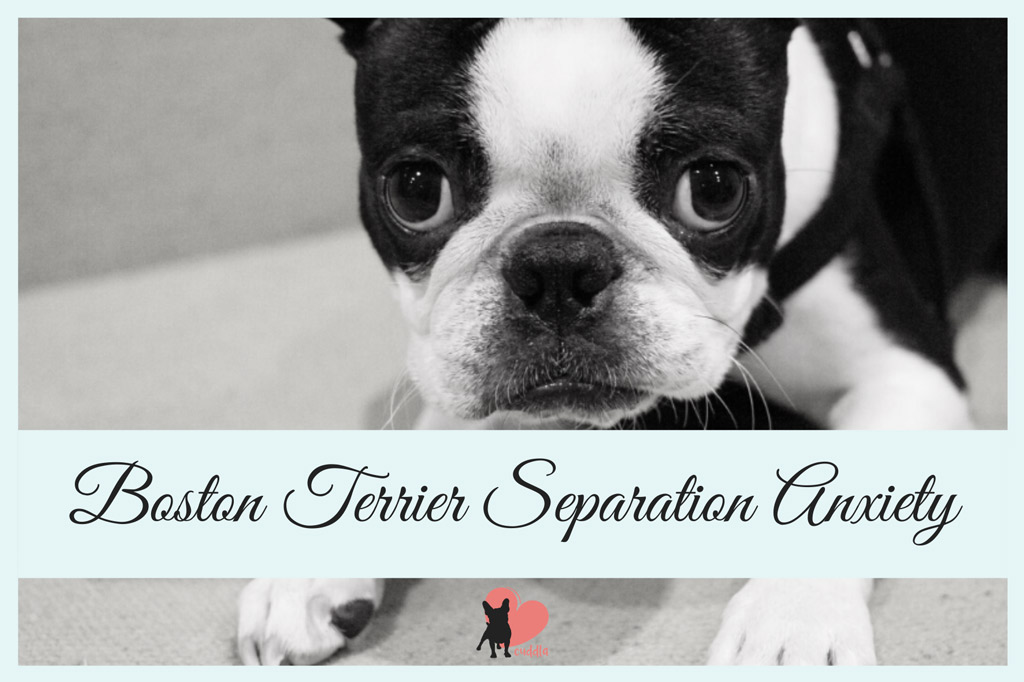
Have you ever noticed your Boston acting “a bit off” when you are leaving the house without him?
Or maybe, like me, you wonder if your furry friend can become anxious when alone…
Do Boston Terriers have separation anxiety? Yes, Boston Terriers can develop separation anxiety when separated from their owners even when they are not left alone for long.
Continue reading to discover the signs, causes, and how to help a Boston Terrier with separation anxiety.
Boston Terrier Separation Anxiety
Separation anxiety in dogs is a behavioural disorder.
Its main characteristic is a state of extreme anxiety or panic due to the dog being separated from his owner.
When this occurs, the most common visible behaviours are:
- Elimination (i.e., urination and/or passage of bowel movements).
- Destruction.
- Excessive vocalization (i.e., barking, crying).
According to AVMA, separation anxiety is one of the most common canine behaviour problems. 20% to 40% of dogs in the US are diagnosed with this disorder.
Do Boston Terriers Have Separation Anxiety?
Separation anxiety is the most common specific anxiety in companion dogs.
No dog likes to be alone, but those that are very social and have been bred for companionship, like Boston Terriers, can take the separation from their owners badly.
Boston Terriers need lots of social interaction – they are companion dogs after all. So, when left alone they can exhibit anxiety or excessive distress behaviours.
Plus, the situation escalates when a Boston is left home for 8, 10 or 12 hours, up to five days a week.
Which brings the question – how long is too long to leave my dog alone?
Here are some factors to consider:
- Dogs left alone for several hours each day can suffer from isolation distress.
- 10 to 12 hours is too long to leave a dog alone.
- Dogs need to have an opportunity to relieve themselves every 4 to 6 hours.
- Crate training your dog is recommended, but leaving him confined to his crate all day is not fair.
Read also: Can a Boston Terrier Be Left Alone? For How Long?
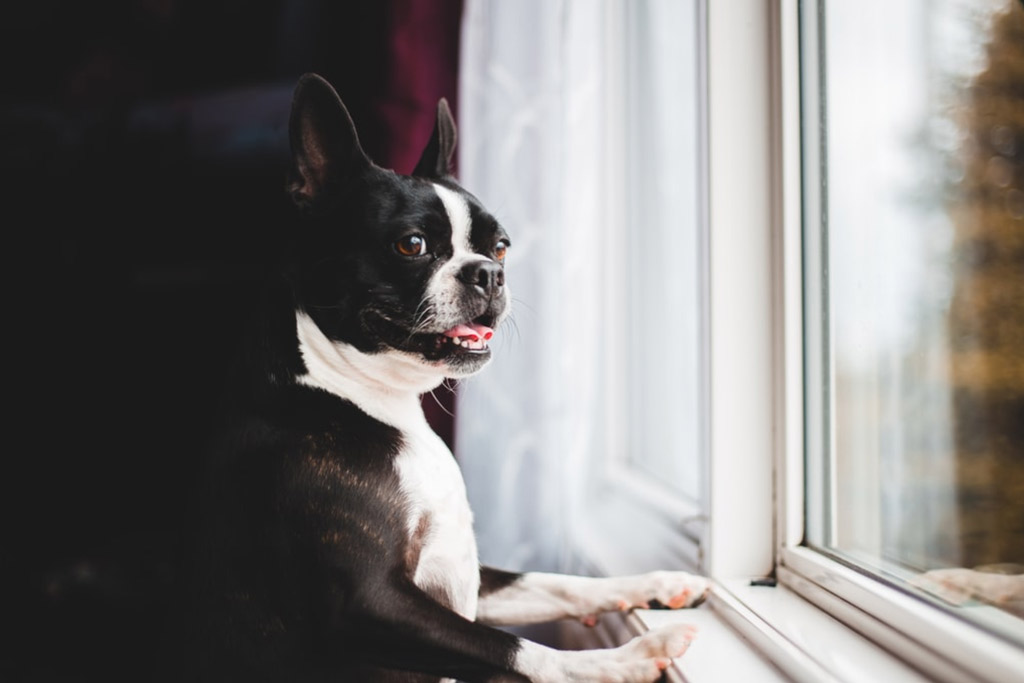
Why Do Boston Terriers Develop Separation Anxiety?
Dogs, in general, are social creatures who get lonely and bored when forced to stay alone for long stretches.
But there is no conclusive evidence showing exactly why dogs develop separation anxiety.
However, far more dogs who have been adopted from shelters suffer from separation anxiety than those kept by a single family since puppyhood. That’s why it’s possible that the loss of an important person or group of people in a dog’s life can lead to separation anxiety.
Other dramatic changes can also trigger the disorder:
- Being rehomed, i.e., a change of family (having multiple owners).
- Being abandoned or surrendered to a shelter.
- Prior neglect.
- An abrupt change in the schedule.
Not only extreme situations impact this sensitive dog breed, Boston Terriers are susceptible to smaller changes too:
- Moving to a new house (with the same family).
- A change in their routine.
- Separation due to the owner’s job or holiday trip.
Fear, on the other hand, can have a single or combination of causes. These are the three basic causes of fear in dogs:
- Genetics.
- Lack of socialization.
- A specific situation caused a fearful response.
Read also: Boston Terrier Fears and Anxiety – Triggers and Remedies.

What Are the Signs of Separation Anxiety in Boston Terriers?
Dogs communicate using body language.
And even if some this body language is more subtle, there are several signs to look out for to determine when your dog is feeling fear or anxiety:
Here’s a list of the 12 most common anxiety signs for dogs:
- Non-stop barking or howling.
- Urine dribbling.
- Chewing everything in sight.
- Exhaling sharply (chuffing).
- Tail thumping.
- Escaping.
- Yawning constantly.
- Shaking and trembling.
- Hiding.
- Scratching.
“Pacing, drooling, constant yawning, lip licking, scratching, and general body tension can all be signs of anxiety. These are collectively known as ‘calming signals.’ They’re also normal behaviours, but are potential signs of anxiety when they’re out of context.”
Kayla Fratt, an associate certified dog behavior consultant.
Separation Anxiety Signs Before You Leave Home
Here’s how separation anxiety can look like before you leave the house:
- Your Boston Terrier gets very anxious when you are about to leave. Your pooch will panic when he hears your keys jingling, or see you put on your shoes, for example. However, some dogs can tell even before you start getting ready!
- He follows you around the house. He might whine and shake whilst at it.
- Your Boston looks sad. This reaction can be more unsettling for you than the other behaviours.
- He gets in front of the door with a “you take me with you, or you are not leaving” attitude. Some can even get aggressive towards their owners.
- After closing the front door, you hear your Boston winning or barking. Sadly, they can continue being vocal for a while after you leave.
Separation Anxiety Signs Once You Leave
Once your Boston Terrier is alone, he’s anxious behaviour will get worse. It usually peaks within 30 minutes of your departure.
Your Boston might:
- Bark or whine endlessly.
- Scratch surfaces like the window, the door, the gate or his crate.
- Chew whatever is in his line of sight (furniture, sofa, pillows, etc.)
- Urinate or defecate inside the house.
- Injure himself by licking or chewing his legs (extreme cases).
Separation Anxiety Signs When You Return Home
When you return home, it’s likely that your Boston Terrier is overly excited. He will bounce around and even jump at you. This state of frenzy can last more than 30 seconds.
It can be easy to misunderstand this “welcome home greeting” and encourage it. Unfortunately, this is more likely to worsen the separation anxiety behaviour.
That’s why it’s best to “ignore” your pooch until he settles down – yes, that is very hard to do! But only after settling down should you greet your Boston in a calm manner and tone of voice.
Tilly, a rescue Jack Russell Terrier cross that we fostered, would jump around for two full minutes! She went as far as to exhaust herself and then seek her water bowl. Sometimes she would choke on the water too!
It was tough to ignore her behaviour, and sometimes, her continuous jumping got very frustrating for us.
So, let’s see what you can do to help your Boston Terrier! 🙂

16 Things that Help Boston Terriers With Separation Anxiety
There are three areas that you can address to help your Boston Terrier overcome separation anxiety:
- Following a separation anxiety protocol.
- Making the transition easier.
- Trying calming remedies.
Follow a Separation Anxiety Protocol
#1 – Start By Redirecting Your Boston Terrier’s Behaviour
You want to make sure you are not encouraging his anxiety. Make sure that you are not paying attention to your Boston when he’s showing separation anxiety signs.
So, ignoring his behaviour is the first step i.e. you are not going to acknowledge your pooch until he stays calm.
Then, you want to flip the situation to something positive for your dog, like playing tug (make sure to praise your Boston Terrier when he follows your lead).
Also, you should keep your cool when interacting with him. Communicate in a calm manner and tone of voice. All these are positive signals for your Boston Terrier and he will feel reassured.
#2 – Train Your Boston Terrier to Be Home Alone
As part of the socialization process, you should train your Boston Terrier to be okay to stay home alone for a while.
Although it’s tempting to spend every moment you can with your lovely pooch, it’s important that they have a time-out from you.
Getting your pooch gradually ready to be alone will result in a confident dog that stays calm and comfortable by himself. He will learn that he’s safe and that you will always return home to him.
For achieving that, train your Boston from day 1, regardless of having a pup or a rescue adult dog. Crate training is a useful method for this.
You can start with 5-minute sessions and build up to 20 minutes.
- At first stay at home, by your dog’s side.
- Then, just out of your dog’s sight.
- And gradually step out of the house.
Read also: Boston Terrier Socialization In 8 Steps and Boston Terrier Crate Training In 8 Steps blog posts.
#3 – Promote Independence
You can promote your Boston Terrier’s independence. Here are some suggestions to achieve this:
- Ignore needy behaviours and attention-seeking attitudes. This doesn’t mean that you shouldn’t show love to your dog, just don’t do it when he’s anxiously asking for it. Let him calm down and then praise him with some playtime or a caress. Remember to keep calm – your expressions & feelings influence your Boston’s attitude.
- Encourage quiet and calm times. Put a food toy such as a Kong by your feet while you are watching TV or reading on the sofa. Gradually place it further away from you over the space of a few weeks. This will teach your Boston Terrier to settle down and engage in activities without you. During this time you should still go in and out of the room as normal.
- Limit your dog from following you around. Install a baby gate in the house to keep your pooch away from certain areas of the house. This also will prevent him from following you around at all times and is an effective way to train your dog to remain calm when you are not nearby.
Insider Tip: Remember that by sticking to a routine, your Boston Terrier knows what to expect and can handle stressful situations better.
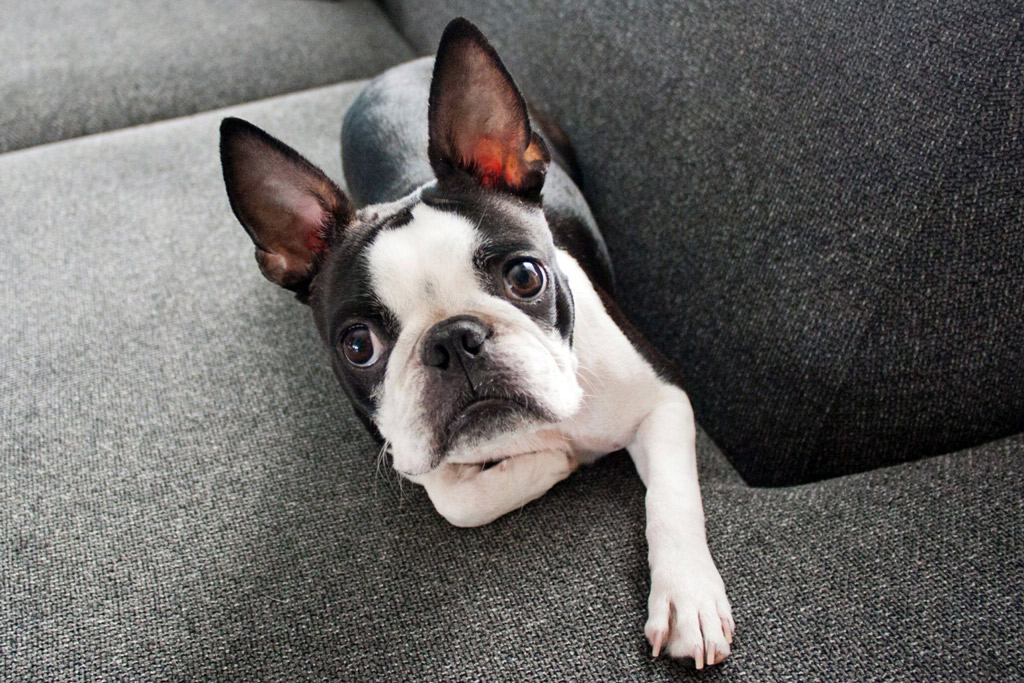
Make the Transition Easier…
While training your Boston Terrier to overcome his separation anxiety, there are a few things that can help:
#4 – Create a Dog Safe Zone
A dog safe zone isn’t hard to create, but it does require some thought. You want to make sure that your Boston Terrier’s spot is safe and comfortable for his inquisitive nose and playful manners.
These zones are very important, especially when considering a study that showed 42-58% of dogs tend to react to stress and anxiety by hiding or withdrawing, depending on the situation (source).
So having a safe space or a den for your Boston with a bed, blanket and special toys help, especially if it’s located in a relatively quiet spot in the house.
#5 – Consider Working from Home
Depending on the kind of work you do, working from home might be an option. Consider working from home a few days a week or full-time.
I personally work from home (which is a great advantage for dog fostering – something I feel strongly about) and use the opportunity to train my dogs on being OK with alone time and promoting independence, while still showing them I am around.
#6 – Take Your Dog to Work
Alternatively, you could bring your Boston to work if your company is pet-friendly.
Of course, this depends on your job requirements and company policy, so find out if you can bring your dog to work with you.
Take the opportunity to read and encourage the benefits of having a dog and taking him to work, if you want to win some votes ;).
#7 – Go Home for Lunch
If working from home and taking your pooch to work are not an option, could you go home for lunch?
If your workplace is close enough, consider returning home at lunchtime to walk your Boston Terrier. Breaking down the alone time can help with separation anxiety.
#8 – Hire a Dog Sitter
Finally, you could ask a close relation to dog-sit or hire a dog sitter. Companionship and exercise are great remedies for separation anxiety.
Try exercising your Boston before leaving to encourage a calmer attitude when you leave. Otherwise, hire a dog walker to ensure that your pooch gets a walk whilst home alone.
There are a lot of dog walking services around these days, depending on where you live. If you decide to go this route, be sure to do your homework and find a reputable one i.e. hire a professional dog walker. Check my favourite dog care for more!
Read also: Can a Boston Terrier Be Left Alone? For How Long?
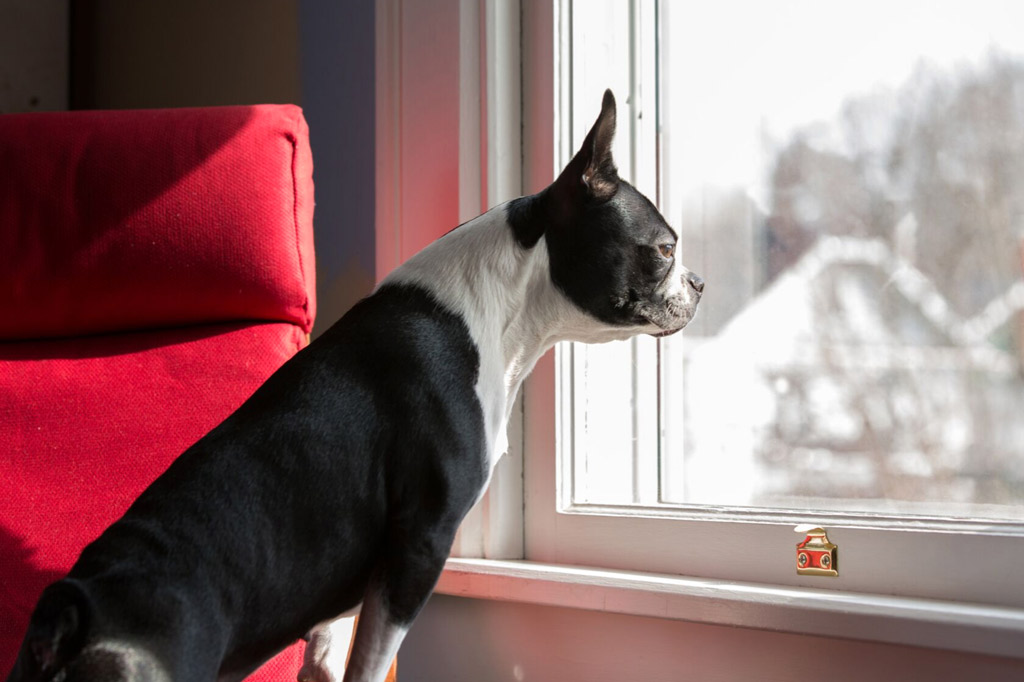
Try Calming Remedies…
In this last section, I want to mention some calming remedies that you can try to help your Boston Terrier. 🙂
#9 – Interactive Toys
When you leave your dog at home alone, leave a treat-release toy for him to focus on in your absence.
These interactive toys are a great addition to your dog room:
- A seek-a-treat puzzle: A Snuffle Mat challenges your Boston to use his nose and paws to find treats.
- A dog puzzle or “busy box” toy: It’s designed to challenge your dog. It contains compartments that hide food and require your pooch to figure out how to get to the food using his nose, mouth, and paws. Trixie puzzle toy, for example, has different training levels to increase the challenge!
- A treat ball toy: Bob-A-Lot gives your pooch something fun to chase around the room and surprise him with a tasty reward!
- Dispenser toys: Kongs are a classic option in this range. It comes in all sizes and for all ages. You can fill it with part of his meal. Also, you can freeze it for an extra challenge.
#10 – Plush Toy
A companion reminder is a great solution to provide comfort to your Boston Terrier.
You can either:
- Leave him with a piece of clothing with your scent on it.
- Or, a plush toy designed to soothe dogs like Smart Pet Love’s Snuggle Puppy Toy.
#11 – Soothing Music
Although you want to keep all departures low-key, your Boston will likely note the imminent silence if you live in a noisy household.
Leave the radio on or even record your family going about their usual daily home life and play it back when you leave your pooch alone.
Also, you can play calm, soothing music or white noise sounds before a possible stressor occurs. This may relax your dog and have the added bonus of drowning out distressing noises.
#12 – A Massage
Massaging your Boston Terrier and talking softly can help. You can give your dog a home massage by rubbing his belly gently.
For example, Ttouch is a specific massage technique that can help anxious pets. Tellington TTouch is a gentle, positive method for training and healing companion animals. It has the power to reshape a dog’s behaviour through kindness and understanding.
Check out the book Getting in TTouch with your Dog: A Gentle Approach to Influencing Behaviour, Health and Performance (Amazon link) to learn more about this massage technique.
#13 – An Anxiety Wrap
If your Boston Terrier seems to respond well to pressure applied to his body, there are wraps available like Thundershirt anxiety jacket that can be very helpful.
#14 – A Herbal Infusion
Calming herbs that can be of benefit include ashwagandha and chamomile. Consult your holistic veterinarian about which makes sense for your Boston Terrier.
#15 – Lavender Essential Oil
The lavender essential oil has also been proven to reduce a dog’s stress response. You can place two drops on your Boston’s collar or bedding before a stressor occurs.
Otherwise, you can use a diffuser (like I do) around your house for an overall calming effect.
#16 – Adaptil
As an alternative to lavender, Adaptil it’s a well-known diffuser to curb stress-related unwanted behaviours. The diffuser emits an odourless pheromone that provides a strong signal of comfort and security to dogs.
Read also: 10 Steps to Dog Home Alone Safety and How to Keep My Dog Entertained While at Work blog posts.
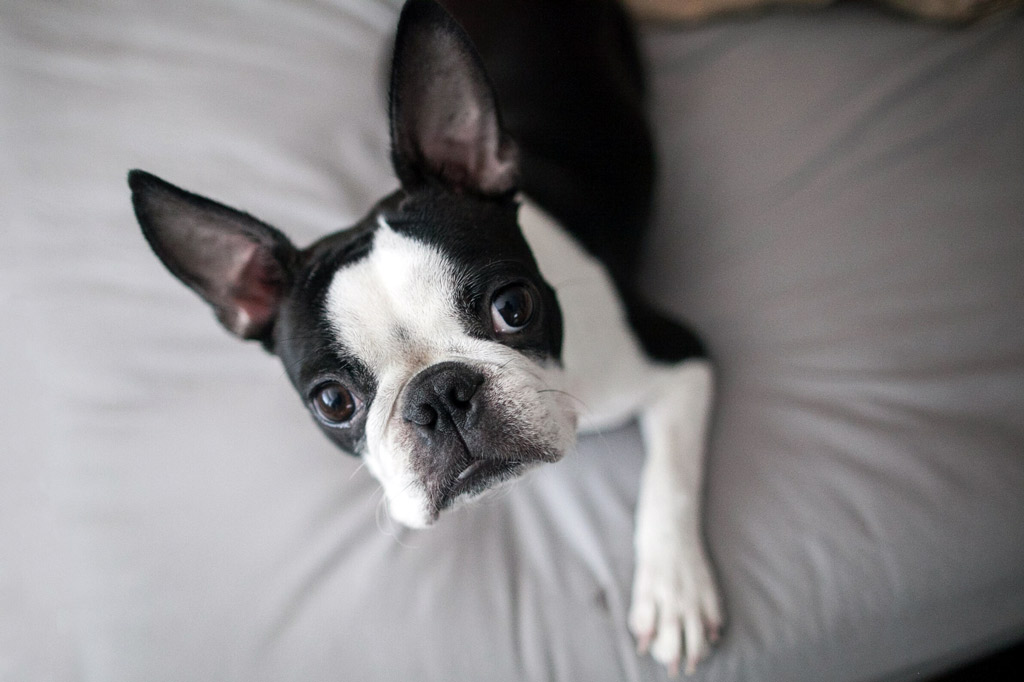
What You Shouldn’t Do If Your Boston Terrier Has Separation Anxiety
Finally, there are three things that you should avoid doing, especially if your Boston Terrier has separation anxiety:
- Don’t get angry: Although teaching your Boston to overcome anxiety can be tough and challenging, stay strong, positive, and don’t get angry. Boston Terriers are sensitive to your tone of voice and feelings.
- Don’t punish: Punitive training methods like shock collars, yelling, hitting, etc. don’t work; they only make things worse. Boston Terriers are also very sensitive to negative training methods.
- Don’t yell “No”: Saying “no” to your doggie without offering an alternative turns your “no” into an interruption, not a request or demand.
Remember that it’s okay to seek help, so don’t hesitate to check my favourite dog care to get a professional in your team!
